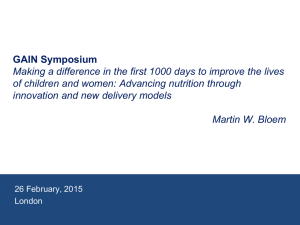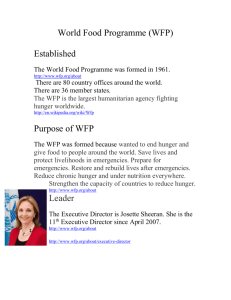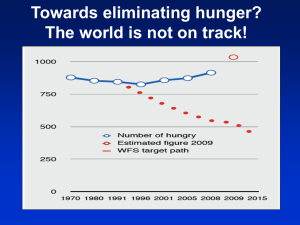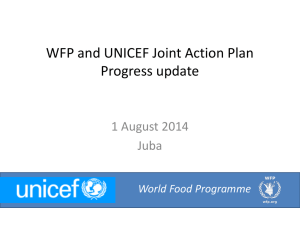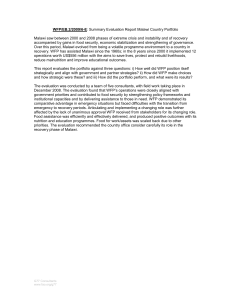Two Minutes on Social Protection
advertisement
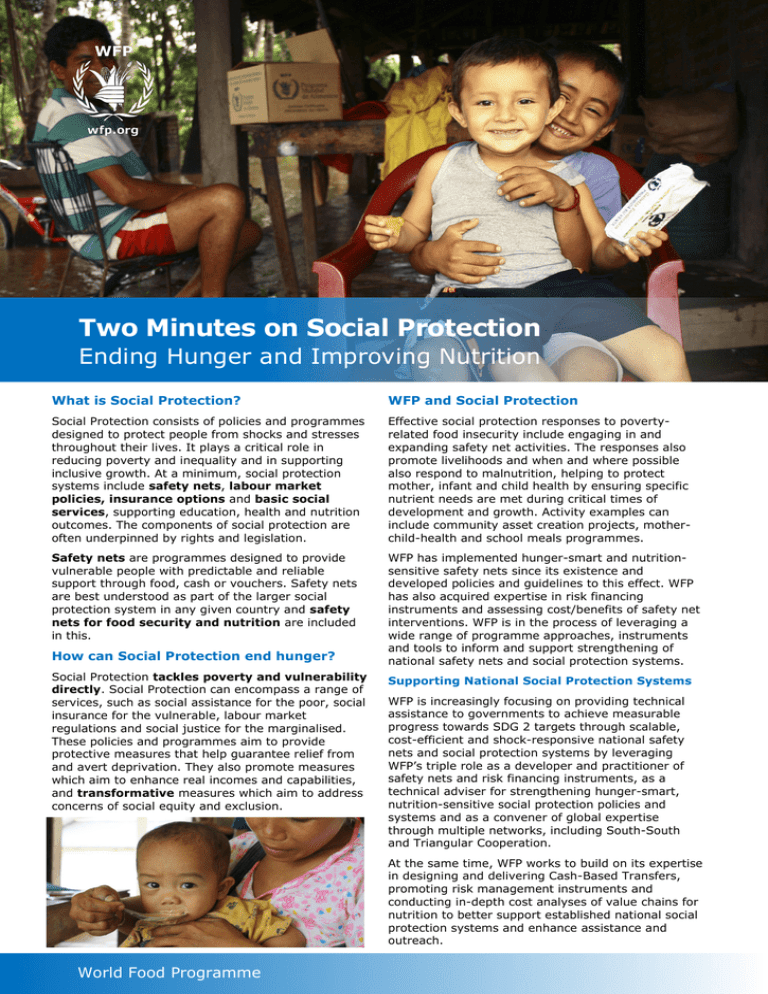
Two Minutes on Social Protection Ending Hunger and Improving Nutrition What is Social Protection? WFP and Social Protection Social Protection consists of policies and programmes designed to protect people from shocks and stresses throughout their lives. It plays a critical role in reducing poverty and inequality and in supporting inclusive growth. At a minimum, social protection systems include safety nets, labour market policies, insurance options and basic social services, supporting education, health and nutrition outcomes. The components of social protection are often underpinned by rights and legislation. Effective social protection responses to povertyrelated food insecurity include engaging in and expanding safety net activities. The responses also promote livelihoods and when and where possible also respond to malnutrition, helping to protect mother, infant and child health by ensuring specific nutrient needs are met during critical times of development and growth. Activity examples can include community asset creation projects, motherchild-health and school meals programmes. Safety nets are programmes designed to provide vulnerable people with predictable and reliable support through food, cash or vouchers. Safety nets are best understood as part of the larger social protection system in any given country and safety nets for food security and nutrition are included in this. WFP has implemented hunger-smart and nutritionsensitive safety nets since its existence and developed policies and guidelines to this effect. WFP has also acquired expertise in risk financing instruments and assessing cost/benefits of safety net interventions. WFP is in the process of leveraging a wide range of programme approaches, instruments and tools to inform and support strengthening of national safety nets and social protection systems. How can Social Protection end hunger? Social Protection tackles poverty and vulnerability directly. Social Protection can encompass a range of services, such as social assistance for the poor, social insurance for the vulnerable, labour market regulations and social justice for the marginalised. These policies and programmes aim to provide protective measures that help guarantee relief from and avert deprivation. They also promote measures which aim to enhance real incomes and capabilities, and transformative measures which aim to address concerns of social equity and exclusion. Supporting National Social Protection Systems WFP is increasingly focusing on providing technical assistance to governments to achieve measurable progress towards SDG 2 targets through scalable, cost-efficient and shock-responsive national safety nets and social protection systems by leveraging WFP’s triple role as a developer and practitioner of safety nets and risk financing instruments, as a technical adviser for strengthening hunger-smart, nutrition-sensitive social protection policies and systems and as a convener of global expertise through multiple networks, including South-South and Triangular Cooperation. At the same time, WFP works to build on its expertise in designing and delivering Cash-Based Transfers, promoting risk management instruments and conducting in-depth cost analyses of value chains for nutrition to better support established national social protection systems and enhance assistance and outreach. World Food Programme Two Minutes on Social Protection Ending Hunger and Improving Nutrition Safety Nets WFP supports the design, development and implementation of hunger-related safety nets that aim to improve the food security and nutrition of the most vulnerable. For example, through Food for Assets (FFA) programming, WFP works extensively on productive safety nets which provide poor and vulnerable households that participate in the creation and protection of assets with food, cash and/or vouchers that help cover immediate food gaps and allow households to allocate resources to additional livelihood activities or other necessary needs. School meals are another effective safety net, as they help ensure every child has access to education, health and nutrition. In the fight against hunger, school meals are a sound investment in the future of the next generation and WFP is working towards a world where school feeding is universal. Focus on Nutrition A large part of WFP's nutrition programmes assist pregnant women, mothers and children during the first 1,000 days, from before birth to two years of age with supplementary feeding. At the same time though, WFP works with partners to support a range of other activities during this period, including disease prevention, optimal breast feeding practices, and good hygiene, to ensure the Safety Nets and Social Protection Unit (OSZIS) Policy and Programme Division wfp.org/social-protection socialprotection@wfp.org many context-dependent factors that can influence nutrition and growth are addressed through social protection and safety net interventions. Nutrition-sensitive social protection targets the most vulnerable, and can be an important strategy in addressing the underlying causes of malnutrition. Social safety nets can help tackle both the immediate and underlying causes of malnutrition by reducing vulnerability, protecting incomes, crops and assets, ensuring basic needs can be met, securing access to a nutritious diet and supporting access to health services, safe drinking water and better sanitation. Safety nets may also achieve impacts on nutrition by providing a platform to deliver nutrition-specific interventions, like complementary foods or nutrition education related to breastfeeding for infants and feeding practices for young children. Some recent examples include a programme in Bangladesh that provides women with cash if they attend training on nutrition behavioural change and an urban safety net programme in the Republic of Congo that provides pregnant and breastfeeding women and people living with HIV or tuberculosis with electronic vouchers and nutritional supplements. WFP is working to ensure that clear nutrition objectives are defined at programme design stage and that indicators measuring impact are identified and measured on an ongoing basis. February 2016
